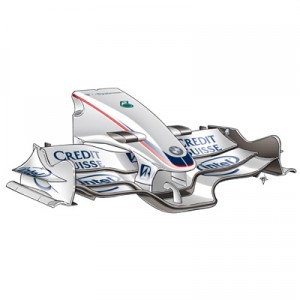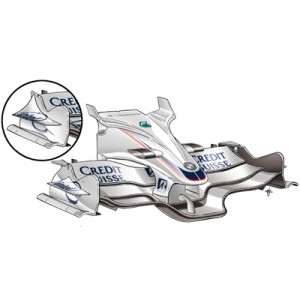BMW Sauber F1: The Chassis Over the Course of the Season
BMW Motorsport has released a review of how the F1 Sauber chassis changes over the course of the season to adjust for competition at various circuits. Following is the release along with some outstanding images of the aerodynamic revisions to the Formula 1 car chassis.
The BMW Sauber F1.08 over the course of the season.
Munich/Hinwil, 13 November 2008. There is a rule of thumb in Formula 1: Standing still means going backwards. Vehicles change from race to race. The engineers are continually modifying the vehicles depending on the characteristics of the different circuits – the extremely long straights in Monza require a different aero package than the tight and slow corners in Monaco. Willy Rampf, the Technical Director of the BMW Sauber F1 Team, uses a selection of technical drawings to describe the constant change undergone by the BMW Sauber F1.08.
Car Launch, Munich, January 2008.
Mr. Rampf: “The elimination of traction control meant that the cars would be more difficult to drive. Our goal was therefore to build a stable car with precise feedback at the front axle and lots of grip at the rear axle, in order to make the driver’s job easier. As far as aerodynamic efficiency was concerned, we wanted to take a significant step forward by comparison with the F1.07. We were able to achieve this objective by a number of measures including a special, compact engine cover. We opted for a very dominant front wing, the great potential of which allowed us to compensate for the entire range of different weight distributions. The vent chimneys combined with the lamellar outlet vents to permit good cooling without significant disadvantages for aerodynamics even under extreme conditions. By contrast with the rim covers, the Tomcat wings on the car’s nose and the vertical sidepod reflectors were not fitted to the car for the presentation.”
axle, in order to make the driver’s job easier. As far as aerodynamic efficiency was concerned, we wanted to take a significant step forward by comparison with the F1.07. We were able to achieve this objective by a number of measures including a special, compact engine cover. We opted for a very dominant front wing, the great potential of which allowed us to compensate for the entire range of different weight distributions. The vent chimneys combined with the lamellar outlet vents to permit good cooling without significant disadvantages for aerodynamics even under extreme conditions. By contrast with the rim covers, the Tomcat wings on the car’s nose and the vertical sidepod reflectors were not fitted to the car for the presentation.”
Melbourne, March 2008.
“We optimised lots of details in the car during extensive winter tests and hence made good progress. However, only some of these modifications were visible. The newly mounted Tomcat wings influenced the air flow round the cockpit and therefore improved the aerodynamics at the rear end. The vertical sidepod reflectors calmed the air turbulence around the front wheels and ensured maximally harmonious flow of air along the sidepods. The underbody benefited from this, in particular the diffuser. A minor modification to the tuning vane was also working towards the same goal. The monocoque wing conducted the air flow downwards, particularly from the mid-section of the front wing. The rim covers were not used in Melbourne because they changed the balance of the vehicle in a way that did not match the characteristics of this circuit.”
Monaco, May 2008.
“Monaco demands maximum downforce. This means that parts are used where the aerodynamic efficiency is not particularly good, but which generate additional downforce. That is the circuit with the lowest average speed and downforce therefore has maximum priority there. We used the front wing with maximum downforce potential. The modified synchroniser retainer plates with the top deflectors combine with the flap to exert significant influence on the flow of air around the front tyres. There was also a small T-wing for more downforce on the so-called batman in front of the rear wheels. The rear wing with the steepest wing position and maximum tread pressure was used. This was also mounted over central supports on the gearbox. We used rim covers in a modified version for the first time, which also generated additional downforce.”
speed and downforce therefore has maximum priority there. We used the front wing with maximum downforce potential. The modified synchroniser retainer plates with the top deflectors combine with the flap to exert significant influence on the flow of air around the front tyres. There was also a small T-wing for more downforce on the so-called batman in front of the rear wheels. The rear wing with the steepest wing position and maximum tread pressure was used. This was also mounted over central supports on the gearbox. We used rim covers in a modified version for the first time, which also generated additional downforce.”
Montreal, June 2008.
“Together with Spa, Montreal is the only medium-downforce circuit. The aerodynamic efficiency plays a very special role here. We used a front wing with smaller, modified flaps. The Tomcat wings also had to give way in favour of lower drag. The rear wing was again mounted on central supports and represented a new development. We also adapted the rim covers to the special requirements. No other circuit puts such a strain on the brakes as Montreal and we therefore paid particular attention to optimum cooling. Our one-two victory was not only the reward for the racing team on the track but also for all those people who are responsible for the development of the car in Hinwil and in Munich.”
Monza, September 2008.
“Monza is the only genuine high-speed circuit left in the calendar. We therefore used a low downforce aero package which was deployed exclusively at this venue. The main focus is on reduction of the drag. We accepted a thirty-percent loss of downforce compared with Monaco and used a completely different front wing with only two elements. While the Tomcat wings were omitted, there were two additional wings on the monocoque, known internally as Manta Rays, which conducted the air flow optimally over the engine cover and hence improved the effect of the rear wing. The side wings on the engine covers were omitted for reasons of drag. The rear wing was very different from the other versions which were used in the course of the season. It had a strikingly small main element and a much bigger flap with serrated Gurney. The synchroniser retainer plates with a clearly defined cut-out were striking. They ensured a stable air flow when cornering.”
wing with only two elements. While the Tomcat wings were omitted, there were two additional wings on the monocoque, known internally as Manta Rays, which conducted the air flow optimally over the engine cover and hence improved the effect of the rear wing. The side wings on the engine covers were omitted for reasons of drag. The rear wing was very different from the other versions which were used in the course of the season. It had a strikingly small main element and a much bigger flap with serrated Gurney. The synchroniser retainer plates with a clearly defined cut-out were striking. They ensured a stable air flow when cornering.”
Tags: BMW Motorsport F1 Sauber, Rampfh

